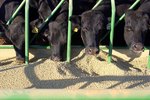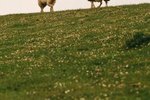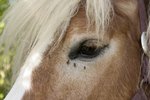
A cow eats plant material like hay and grass that is full of cellulose. Cellulose is very hard to digest, so the cow relies on bacteria and other organisms that live inside them to break down the cellulose into a form from which they can extract nutrients. The ruminant stomach is vastly different from your own digestive system. Without cellulose-digesting bacteria, cows wouldn't be.
The Fermentation Vat Inside
A cow, or any ruminant, has four compartments in her stomach. The largest is called the rumen. This has a massive capacity of 40 to 50 gallons in a mature cow. Within, it contains more bacteria and other microbes than there are humans on Earth. This is where the bacteria work their magic to process the grass and plant matter into a form the cow can digest.
It Takes All Types
Bacteria do most of the digestive work in the rumen, but protozoa and fungi assist. Many types of bacteria exist, and they mainly digest protein, starch, sugars and fiber. They cross-feed, as some bacteria break down specific proteins and carbohydrates into forms that others use. Some bacteria prevent the rumen from becoming toxic by cleaning the waste products of others.
Rapid Multiplication to Survive
The cow digests the nutrients released by the microbes. As the digestive process works, many of the bacteria are swept from the rumen into the rest of the digestive system and also provide nutrients for the cow. To maintain their population in the rumen, they have to multiply rapidly. The population of one type of bacteria can double in minutes.
A Mutually Beneficial Arrangement
The relationship between a cow and the cellulose digesting bacteria is a symbiotic one, meaning both parties benefit. The cow provides the bacteria a warm, moist environment with a constant supply of food. The bacteria enable the cow to access the nutrients in their cellulose-rich diet and provide a protein source.
References
Resources
Photo Credits
-
Comstock Images/Comstock/Getty Images




